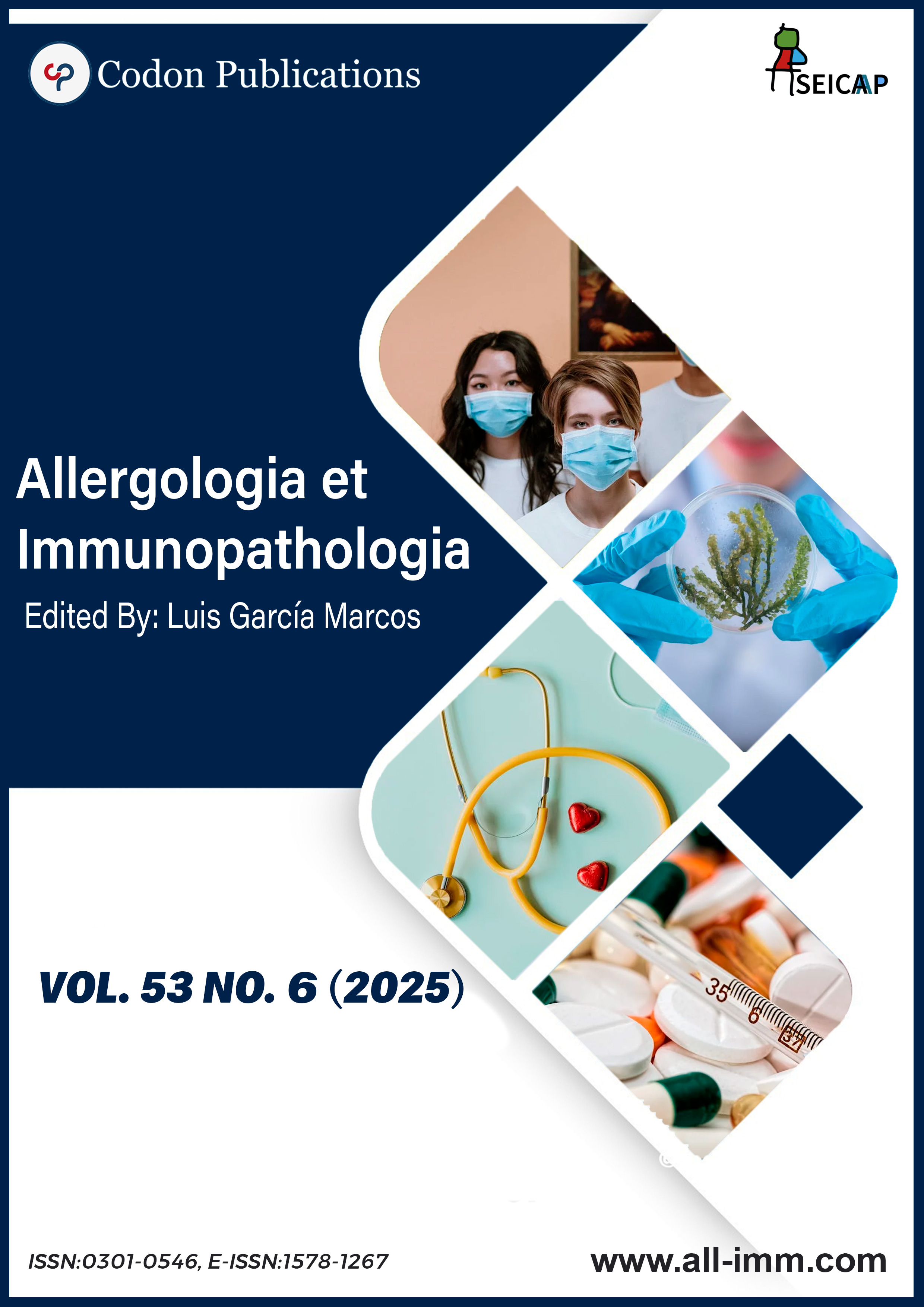Correlation patterns among house dust mite allergens in allergic rhinitis: A molecular sensitization study in Mallorca
Main Article Content
Keywords
House dust mites/immunology, Allergens / analysis, Immunoglobulin e/blood, Rhinitis, allergic/immunology, Molecular diagnostic techniques, Correlation of data
Abstract
Introduction: Molecular characterization of house dust mite (HDM) and storage mite allergens provides valuable insights into sensitization patterns; however, relationships among different mite allergens and their clinical implications remain unclear.
Methods: A total of 100 patients with allergic rhinitis sensitized to Dermatophagoides pteronyssinus were analyzed. Specific IgE (sIgE) levels were measured using singleplex and multiplex assays. Correlations among mite allergens and their associations with clinical and demographic variables were evaluated.
Results: The median sIgE level to Der p was 15.8 kU/L (IQR: 50.25); no relevant Dermatophagoides spp. sensitization was found below 2 kU/L. Among patients with Der p >10 kU/L, 59 of 60 had significant sIgE to at least one major HDM allergen. The highest prevalence was for Der p 1 (92%), though its median level was low (3.19 kU/L, IQR: 8.18). Conversely, Der f 2 had the highest median sIgE (23.4 kU/L, IQR: 33.74). Multivariate analysis revealed that most allergen levels were predictable from clusters of other mite allergens (R2=0.27–0.98). Mite allergen sIgE (Aca s, Blo t 5/10/21, Der f 1/2, Der p 1/2/5/7) correlated positively with sensitization number. sIgE levels negatively correlated with age and positively correlated with atopic dermatitis (Der p 1/2/23, Der f 1/2), asthma (Aca s, Der p 21), food allergy (Aca s, Der f 1, Der p 1), and rural residence (Der p 7).
Conclusion: Der p source allergen reliably excludes clinically relevant sIgE to HDM components. The correlations among mite allergens highlight challenges in clinical relevance assessment, emphasizing the need for component-resolved diagnostics to optimize immunotherapy responses.
References
2 Arlian LG, Platts-Mills TA. The biology of dust mites and the remediation of mite allergens in allergic disease. J. Allergy Clin. Immunol. 2001 Mar;107(3 Suppl):S406–13. 10.1067/mai.2001.113670
3 Acevedo N, Zakzuk J, Caraballo L. House dust mite allergy under changing environments. Allergy Asthma Immunol. Res. 2019 Jul 11(4):450–69. 10.4168/aair.2019.11.4.450
4 Bergmann KC. Biology of house dust mites and storage mites. Allergo. J. Int. 2022 Nov 31(8):272–8. 10.1007/s40629-022-00231-8
5 Ferrándiz R, Casas R, Dreborg S. Cross-reactivity between Dermatophagoides siboney and other domestic mites. II. Analysis of individual cross-reacting allergens after SDS-PAGE and Western blotting inhibition. Int. Arch. Allergy Immunol. 1998 Jul 116(3):206–14. 10.1159/000023946
6 Jakob T, Forstenlechner P, Matricardi P, Kleine-Tebbe J. Molecular allergy diagnostics using multiplex assays: methodological and practical considerations for use in research and clinical routine: Part 21 of the Series Molecular Allergology. Allergo. J. Int. 2015;24:320–32. 10.1007/s40629-015-0087-8
7 Matricardi PM, Kleine-Tebbe J, Hoffmann HJ, Valenta R, Hilger C, Hofmaier S, et al. EAACI molecular allergology user’s guide. Pediatr. Allergy Immunol. 2016 May;27 Suppl 23:1–250.
8 Canonica GW, Ansotegui IJ, Pawankar R, Schmid-Grendelmeier P, van Hage M, Baena-Cagnani CE, et al. A WAO–ARIA-GA2LEN consensus document on molecular-based allergy diagnostics. World Allergy Organ. j. 2013;6:17. 10.1186/1939-4551-6-17
9 Bousquet J, Chanez P, Chanal I, Michel FB. Comparison between RAST and Pharmacia CAP system: a new automated specific IgE assay. J. Allergy Clin. Immunol. 1990 Jun 85(6):1039–43. 10.1016/0091-6749(90)90048-9
10 Lis K, Bartuzi Z. Selected technical aspects of molecular allergy diagnostics. Curr. Issues Mol. Biol. 2023 Jun 45(7):5481–93. 10.3390/cimb45070347
11 Rodinkova VV, Yuriev SD, Kryvopustova MV, Mokin VB, Kryzhanovskyi YM, Kurchenko AI. Molecular profile sensitization to house dust mites as an important aspect for predicting the efficiency of allergen immunotherapy. Front. Immunol. 2022;13:848616. 10.3389/fimmu.2022.848616
12 Posa D, Perna S, Resch Y, Lupinek C, Panetta V, Hofmaier S, et al. Evolution and predictive value of IgE responses toward a comprehensive panel of house dust mite allergens during the first 2 decades of life. J. Allergy Clin. Immunol. 2017 Feb 139(2):541–549.e8. 10.1016/j.jaci.2016.08.014
13 Banerjee S, Resch Y, Chen KW, Swoboda I, Focke-Tejkl M, Blatt K, et al. Der p 11 is a major allergen for house dust mite-allergic patients suffering from atopic dermatitis. J. Invest. Dermatol. 2015 Jan 135(1):102–9. 10.1038/jid.2014.271
14 Čelakovská J, Bukač J, Cermákova E, Vaňková R, Skalská H, Krejsek J, et al. Analysis of results of specific IgE in 100 Atopic dermatitis patients with the use of multiplex examination ALEX2—Allergy explorer. Int. J. Mol. Sci. 2021 May 22(10):5286. 10.3390/ijms22105286
15 Lee CS., Tsai LC., Chao PL., Lin CY., Hung MW., Chien AI., et al. Protein sequence analysis of a novel 103-kDa dermatophagoides pteronyssinus mite allergen and prevalence of serum immunoglobulin E reactivity to rDer p 11 in allergic adult patients. Clin. Exp. Allergy. 2004 Mar 34(3):354–62. 10.1111/j.1365-2222.2004.01878.x
16 Boquete M, Carballada F, Armisen M, Nieto A, Martín S, Polo F, et al. Factors influencing the clinical picture and the differential sensitization to house dust mites and storage mites. J. Investig. Allergol Clin. Immunol. 2000;10(4):229–34.
17 Hervás D, Pons J, Milá J, Matamoros N, Hervás JA, García-Marcos L. Specific IgE levels to dermatophagoides pteronyssinus are associated with meteorological factors. Int. Arch. Allergy Immunol. 2013;160(4):383–6. 10.1159/000342444
18 Letrán A, García I, Espinazo-Romeu M, Moreno-Aguilar C, Moreno F. Cut-off value of D. pteronyssinus specific IgE in double negative patients Der p 1 and Der p 2 and its clinical repercussion. Sci. Rep. 2021 Dec 11(1):23585. 10.1038/s41598-021-03005-4
19 Sánchez-Borges M, Fernandez-Caldas E, Thomas WR, Chapman MD, Lee BW, Caraballo L, et al. International consensus (ICON) on: clinical consequences of mite hypersensitivity, a global problem. World Allergy Organ. J. 2017;10:14. 10.1186/s40413-017-0145-4
20 Valenta R, Lidholm J, Niederberger V, Hayek B, Kraft D, Grönlund H. The recombinant allergen-based concept of component-resolved diagnostics and immunotherapy (CRD and CRIT). Clin. Exp. Allergy. 1999 Jul 29(7):896–904. 10.1046/j.1365-2222.1999.00653.x
21 Walsemann T, Böttger M, Traidl S, Schwager C, Gülsen A, Freimooser S, et al. Specific IgE against the house dust mite allergens Der p 5, 20 and 21 influences the phenotype and severity of atopic diseases. Allergy. 2023 Mar;78(3):731–42. 10.1111/all.15553
22 Kidon MI, Chiang WC, Liew WK, Ong TC, Tiong YS, Wong KN, et al. Mite component-specific IgE repertoire and phenotypes of allergic disease in childhood: the tropical perspective. Pediatr. Allergy Immunol. 2011 Mar 22(2):202–10. 10.1111/j.1399-3038.2010.01094.x

